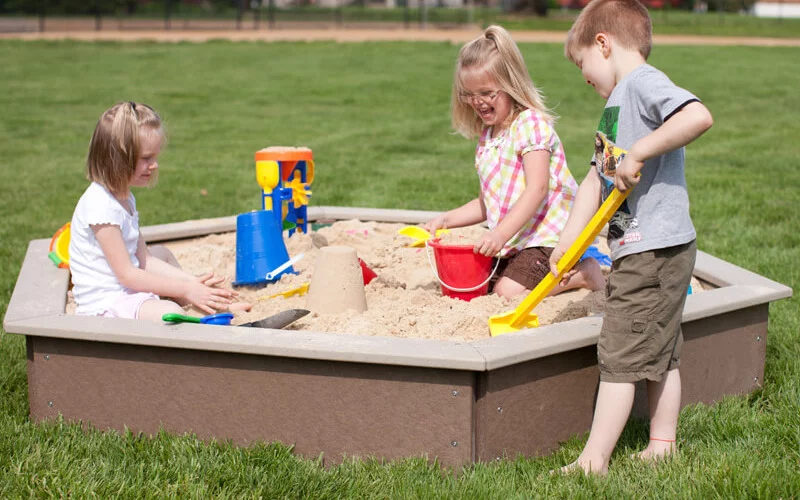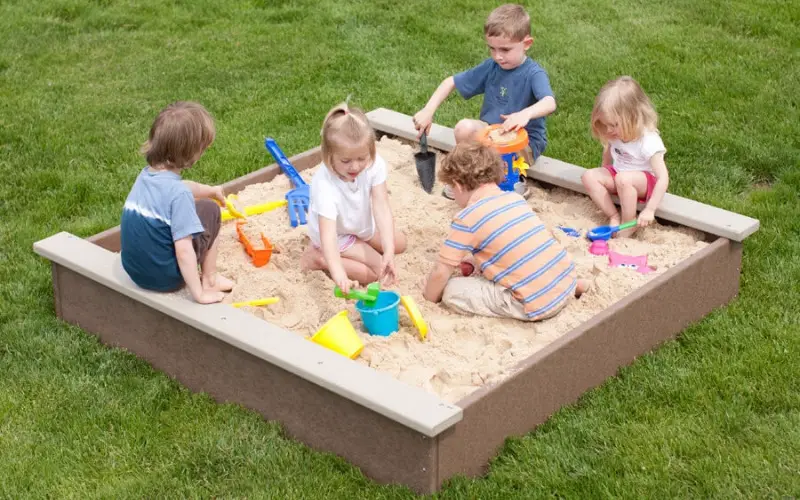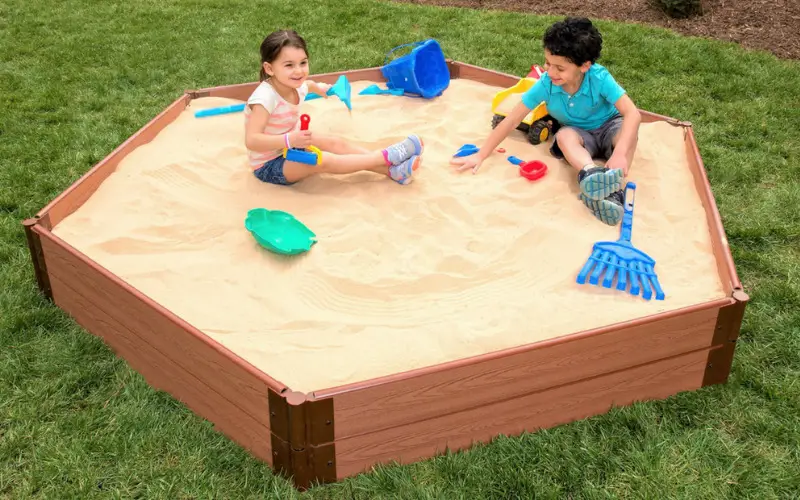Sandboxes are a great way for kids to get a wholesome play that keeps them active and helps them develop physically and mentally.
However, getting the sandbox is the first step to kids’ enjoyment, putting the right amount of sand in the box is the second, and ensuring that kids play there safely is perhaps the most important of all steps.
Since there are different shapes of sandboxes, you will have to do a little math (we promise it’s not one of those calculations) to determine the exact quantity of sand that will be right for your sandbox.
The size of the sandbox and how much you want to fill it are other factors that will affect the calculations.
How Much Sand Sand Does My Sandbox Need?

You can calculate the exact amount of sand you need for the different types of sandboxes, even though some shapes are a little more complicated to determine than others.
The depth to which you fill your sandbox can significantly affect how much sand you will need; however, Sand depth of 1 to 3 inches is ideal as it gives children the liberty to build anything they want.
Anything more than 3 inches may cause the sand to overflow, fill everywhere, and even leave a mess.
You need to measure the dimension of your sandbox the moment you are sure of the depth of sand you want, as it is this dimension that determines the number of sandboxes you will need.
Steps To Calculating The Amount Of Sand You Need For Your Sandbox
Step 1: the most dimension of the sandbox comes in inches, so you have first to convert them to feet, and you do this by dividing the value of the length and breadth by 12.
So if, for instance, the length of the sandbox is 24 inches and the width is 12 inches, and the depth is 6 inches too, what it means is that the dimension of the sandbox is 4 feet long, 2 feet wide, and 0.5 feet deep.
Step 2: you then multiply the length of the sandbox by the breath and the width so that the answer will now be in cubic feet. This means that from the example in step 1 above, the sandbox area is 4 × 2 × 0.5, which means the area is 4 cubic feet.
Step 3: most play sand comes in bags of 50 pounds, and 50-pound of sand will fill 0.55 cubic feet. So to find the number of bags that will be okay for your sandboxes, you divide the answer you got by multiplying the length, breadth, and height by 0.55, and you will know the number of sandbags you will need. So still using the example from the previous steps. The number of Sandbags you will need equals:
0.55 × 4 = 2. 2 bags
What About Circular Sandboxes?
Some sandboxes are circular, and the calculation is different for those types. To calculate the quantity of sand needed for the circular sandbox, you will do the following:
Step 1. You start by measuring the diameter of the sandbox, and then you divide it by 2 to determine the radius.
Step 2: You calculate the volume of the sandbox by using the formula: π multiplied by the square of the radius and the depth of the sandbox.
Step 3. The value you get from the calculation in step 2 you multiply it by 0.55 to get the number of bags that are needed.
The Best Sand for Sandboxes
You might be quick to think that you can use any sand for filling the sandbox your kids play with; after all, sand is sand.
But that is not true; for instance, sand used in construction is not subjected to the same cleaning and processing as the sand used in sandboxes, making them inappropriate for sandboxes because they are more coarse and can harm kids.
Here is some sand that is good for sandboxes:
1. Calcean BAHA Natural Play Sand which comes in 20-pound bags.
2. Classic Sand and Play Sand for Sandbox are great if you buy on a budget.
3. Sandtastik Sparkling White Play Sand this sand is about the best-processed sand that there is.
4. Kinetic Sand, 3.25lbs Beach Sand for Squishing
5. National Geographic Play Sand Combo Pack, sand with a good color variety.
What to Consider When Choosing the Best Sand for Sandboxes

There are different factors that you must consider before choosing the sand your kids use in their sandboxes, and these factors include:
1. The Sand Type
The three types of sand used commonly for filling sandboxes are natural, kinetic, and processed sand. Natural Sand are sands that come from deserts and beaches.
They are a little more coarse than the other kind of sands. Processed sand, on the other hand, which is made in quarries and gravel pits, is smooth; however, you must be careful not to buy ones with silica dust in them.
Kinetic sands are moldable sand because they are coated with polydimethylsiloxane, a non-toxic, silicon-based organic polymer; this is probably why they are a little pricey.
2. The Sand Texture
The three types of sand mentioned earlier all have different textures, with natural sand being the more coarse of them but having the advantage that they are very easy to clean off.
Processed sand has a very fine and smooth texture and comes in different processed levels, allowing you to choose what you want.
Kinetic sand is also processed, but it is to remove contaminants and keep the sand clean. It is also very smooth sand that can be molded easily. It is the easiest of all of the sand types to clean.
3. The Color Of The Sand
Sand comes in different colors, from classic tan to white, purple to blue, and yellow. Your kids might like playing with a particular Sand color better than with others, so it is a good idea to check with them before buying the sand. There is some multicolored play sand that most kids love a lot.
How To Take Care Of The Sand In The Sand Box
There are a few things you can do to maintain the sand in your sandbox; some of them include:
1 Preventing Contamination by keeping the sandbox covered either with the cover it came with, or you can buy retrofit covers, this is to ensure that unwanted visitors like animals, pets, and the likes gain access to the sandbox, this is because some animals like cats can assume that the sandbox is a litter box and so may defecate in it. The cover should be dry so that bacteria do not grow in the sandbox.
2. Ensure that the sand is dry a the time, and if it gets wet in the course of kids playing with it, then dry it out before covering it again.
3. Planting a bug-repelling garden with basil and mint and other such natural, non-toxic insect and rodent repellent near the sandbox helps keep bugs and other such pests away from it.
4. Ensure that leaky diapers do not contaminate the sand by ensuring that the toddlers use clean diapers while playing in the sandbox. Contamination of sandbox by human feces is very common, and this has led to kids contracting E coli, which is especially dangerous for them. If your kids aren’t potty trained, never let them play in the sandbox without diapers.
How To Clean The Sandbox
1. Always clean the sandbox as often as is possible ( the least should be once a week). You should also use a clean litter book and rake to sift through the sand so that you can remove all foreign objects, dirt, and debris that are hidden inside the sand.
2. Change the sand at least once every year, even if it appears clean; this is to ensure that you don’t expose your kids to any form of pathogens that might be hiding in the sand.
3: regularly wash the toys used in the sandbox to further reduce the contaminants they get exposed to. After washing the toys, wile them completely with an adequate disinfectant. Your kids must play with only toys in the sandbox that can easily be cleaned.
4. Always the hands of your kids immediately after they finish playing in the sandbox. This ensures they don’t transfer any germ from the sandbox from their hands to their mouths. And children must never be allowed to eat or drink anything while playing in the sandbox not to contaminate their food.
How To Prevent Injury and Toxic Exposure While playing With sandbox
Here are a few things you can do to ensure that you keep your sandbox safe from an accident:
1. Do not introduce gravel to the sandbox or even keep it near; this is because kids can scratch themselves with it; that is another reason why you have to rake the sandbox every so often to remove gravels that get in mistakenly, to prevent this injury hazard.
2. Do not let splinters of any size find their way to the sandbox; this becomes a real issue if the sandbox is made of wood. If you must build your sandbox with wood, ensure that you use one that will not crack or break. Railroad ties tend to splinter easily, so you must avoid them. Instead, use landscaping timber that works perfectly for sandboxes.
You should immediately sand your wooden sandbox if it begins to splinter. Use a tweezer to remove the splinters. If they pierce your kid’s body, don’t leave it at all because it might get infected.
3. Some wood might look okay, but it might be toxic to the kids. You must never use that kind of wood. Woods that are treated with chemicals to keep them from rotting can become too toxic; if treated with a high dose, you should be wary of making your kids sandboxes out of such woods.
Avoid using any wood treated with Chromated Copper Arsenate; it is too toxic to make sandboxes. All these chemically treated woods are recognizable by the green hue of such timber.
4. some sand contains minerals that will harm kids if they inhale it; one of them is tremolite which some play sand has. To avoid this problem, you should stick to natural sand or those from the river for your sandbox.
5. Do not put in your sandbox any Sand that has crushed quartz, limestone, or marble, as they usually contain tremolite.
6. Lastly, avoid any Sand that is very dusty no matter how good it looks.
7. It is best never to allow your kids to play in public sandboxes because you never know who used them last and what contaminants might be there.
Conclusion
Sandboxes are fun for young kids, especially toddlers, who stay there and create a world of their own, and one of the challenges of buying Sand sandboxes is knowing the number of Sandbags to get.
Once you determine the area of the sandbox container, then multiply it by 0.55 to determine how many Sandbags will fill your sandbox.
You must pick the suitable sand that is dust, chemical, and germ-free so that you do not expose your kids to health hazards.
Taking care of the Sand and the sandbox ensures that your kids do not get into any danger as they play away and create their reality.
You May Also Like:
- Cost To Move a Swing Set
- How To Anchor a Metal Swing Set?
- Best Inflatable Pool Cleaner Tool
- What Brand of Playset is the Best?
- 8 Best Outdoor Towel Warmer For Hot Tub
We trust this article helped you know How to Dry Sand in a Sandbox. You may also want to check out How to Dry Sand in a Sandbox.
Thanks for taking the time to read our article, and we hope you find it helpful. Would you mind leaving a comment below if you have any suggestions?
Kindly reach out to people by sharing this post on social media.
If you liked this article, then please follow us on Facebook, Instagram, and Pinterest.

